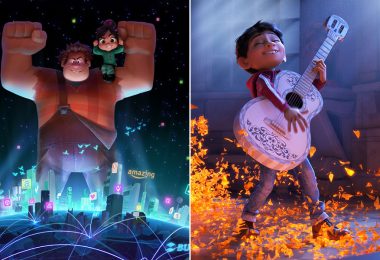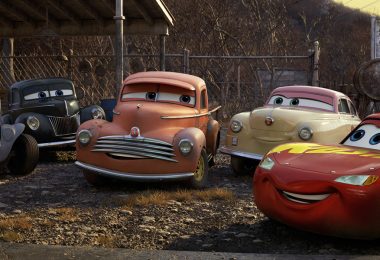By Jim Frye
In Disney•Pixar’s 2006 hit Cars, hot-shot race car Lightning McQueen (voiced by Owen Wilson) dominated the Piston Cup racing series, with help from his mentor and racing veteran Doc Hudson (Paul Newman). The film told the story of one generation helping—and passing the baton to—the next generation.
Well grab your racetrack binoculars, folks, because Lightning and the Radiator Springs gang are back for more laps in Cars 3. This time around, though, the slick new Jackson Storm (voiced by Armie Hammer) wants to leave Lightning in his next-gen dust. “We were really intrigued by what happens to an athlete who’s in the twilight of his career,” says Brian Fee, director. “All Lightning McQueen has ever wanted is to be a champion—and he’s done that. Does that mean his life is over? He doesn’t know anything else.”
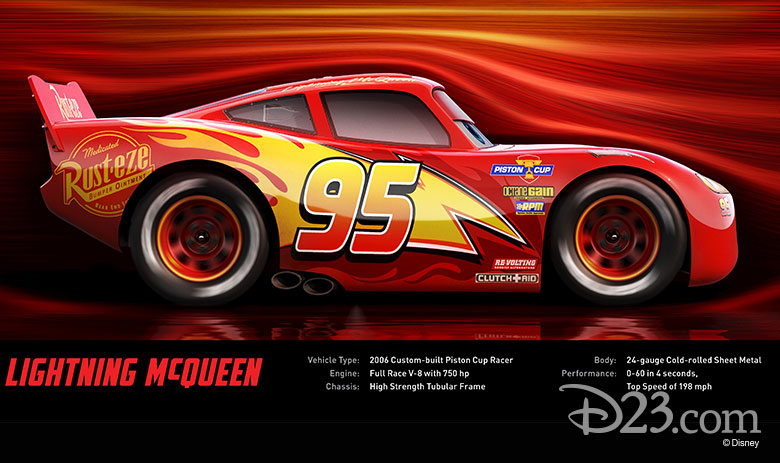
In Cars 3, Lightning gets in a serious accident, not unlike the one that ended Doc Hudson’s career. “But Lightning doesn’t want to go out that way,” says Kevin Reher, producer. “He sets out to make a comeback, but he’s competing against newer, faster cars who are high-tech versions of who he was ten years ago.” Cruz Ramierez (Cristela Alonzo), attempts to help Lightning get his career—and life—back on track.
For the animators at Pixar, designing the motorized characters in Cars 3 involved quite a bit of “elbow grease.” They needed to look into the future and create cars that are drastically different than what we’ve seen before while staying true to their character. “In the world of Cars, colors and shapes help define these characters,” says Jay Shuster, production designer. “You want them to be true to what they’re made of—the steel and the plastics and what not.”
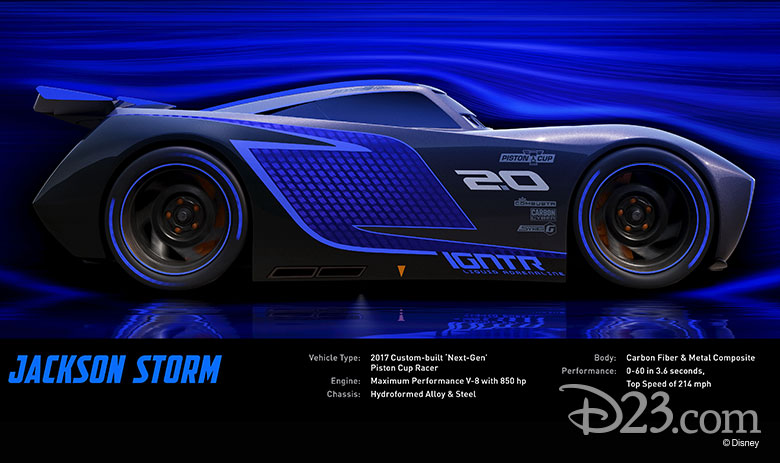
Designing Jackson Storm
When Lightning first burst on the scene in 2006, he was the most state-of-the-art car in the Piston Cup series. “He was the next generation of his era,” says Shuster. “And for that movie, we designed McQueen to make every other racer look outdated.” But in Cars 3, there’s a new—and technologically advanced—competitor. “We tried to design McQueen’s rival to be a next generation racer who would push McQueen to the brink of extinction,” continues Shuster. “So we asked ourselves, what would a race car design in McQueen’s league look like 20 years into the future? Enter Jackson Storm.”
The team started with a blank sheet of paper. “At Pixar we have this iterative design process—get all our ideas up on a wall as soon as possible. Just get every idea out. Scratch it down on paper any way you’ve got. All different manners of designs, directions” says Shuster. “McQueen is running, flowing—so Storm, therefore, had to be angular in shape. Storm has a super low profile, a very aggressive shape. You can see the contrast between McQueen and Storm. It’s obvious how outdated McQueen is. He looks slow next to Storm. Storm’s profile is low to the ground, as opposed to McQueen’s upright posture.”

One thing that designers pay special attention to is the eye-mouth relationship on each car. Since the characters’ eyes are in the windshield, designers have to be careful not to lean the windshield too far back, because it looks as if the character is staring up into the sky. Says Shuster, “We have to be really attentive to the angle so that it relates to the mouth and it emotes to the audience.”
Some early sketches of Storm presented him with more of a stock car/NASCAR appearance. Designers then added in mass and muscle, to make him more aggressive.
“Just like in the automotive world, we use clay to build some of these characters in our films,” says Shuster. “We can design this character 1,000 times, draw it 1,000 times, but we still don’t have an idea of what it looks like in the round. Paper is great 2D, but we’ve got to get it into the 3D realm, just to know what these shapes do.” They take the character sculpts and “trace” them, either digitally or traditionally with trace paper. They then hone them, push them, perfect them—always careful to consider the relationship between the mouth and the eyes.
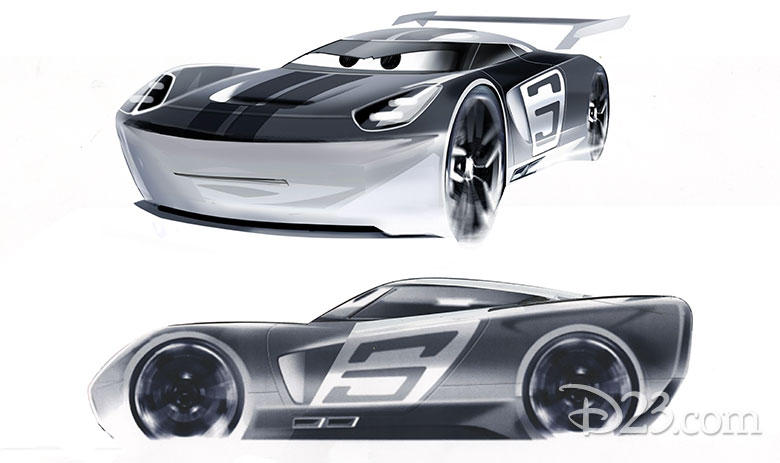
“I like to say that every line has something to say about this character,” Shuster continues, pointing at design sketches of Storm. “Storm is basically a weapon on wheels, so we’ve got these lines, these creases that are super aggressive. Everything’s sharp and stealthy and communicates well in that sketch. Now, past the clay stage, we finally start building Storm in the computer and we’re holding this character up, constantly comparing it to McQueen, making sure he contrasts well with McQueen’s shapes.”
To finish Storm’s appearance, designers added bold, elegant graphics. And in the same way that McQueen has his iconic lightning bolt, Jackson has his own iconic symbol—the international symbol for hurricane, complemented by a dark, sinister paint scheme. “We gave McQueen a rival that completely defines the next generation,” says Shuster. “And we exploited shape, paint, and graphic to yield a character that needs very few words to express his intentions.”
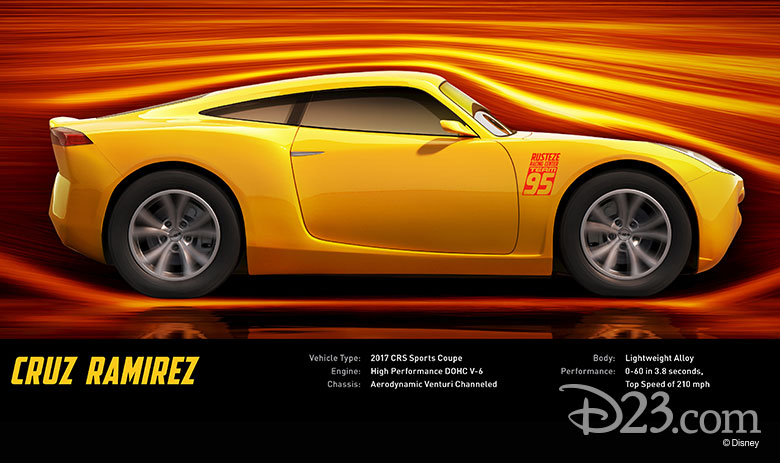
Designing Cruz Ramirez
For Cruz Ramirez, Lightning’s high-tech trainer, they went a different direction. “We really wanted Cruz’s shape to be based on American muscle car proportion, but also informed by European sports car elegance,” says Shuster. “We wanted Cruz to live somewhere between McQueen and Storm. She has just enough creases and hard edges to look modern, yet with more flowing, elegant shapes.”
Usually, the animators start with a blank sheet of paper when designing a character, but they also rely heavily on videos of the actor who will be portraying that character. They watch these videos closely to help capture a character’s actions and mannerisms. It can really spark the design process.
Cruz is not a race car, per se. However, she’s a strong female character who can meet the next generation racer on their level. “We really emphasized that kind of American muscle,” says Comet. “She’s got that American kind of style, mixed with some of those hard edge creases. That makes her look faster and quite capable.”
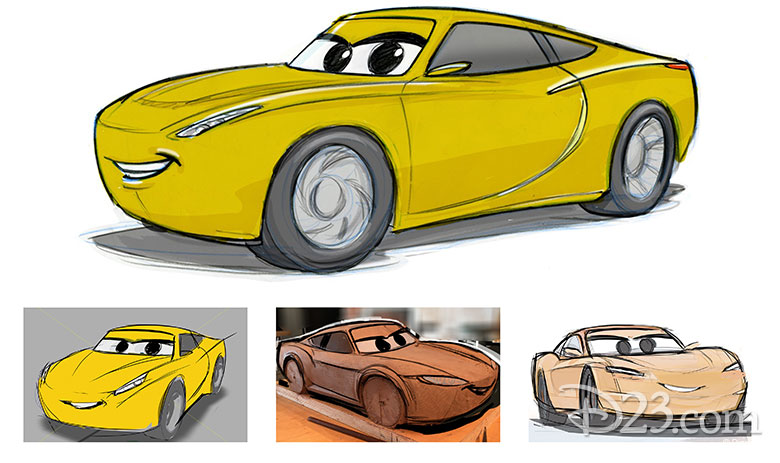
And what about her yellow color? “It was the most vibrant option,” says Shuster. “She has a very vibrant personality, so we wanted something that really kind of just popped.”
Michael Comet, character supervisor, explains that color process: “To add color and add shading, what we do is we have a team of digital shading and painting artists. They can do things like control shininess and color, reflectivity. And then what we do is we take those materials and we apply them back onto these vehicles.”
“I think she looks really great,” he says. “You can see all that detail of the model headlights, all the reflections in her clear coat, see things like the rigging where the tire’s contacting the ground and some great posing by animation.”
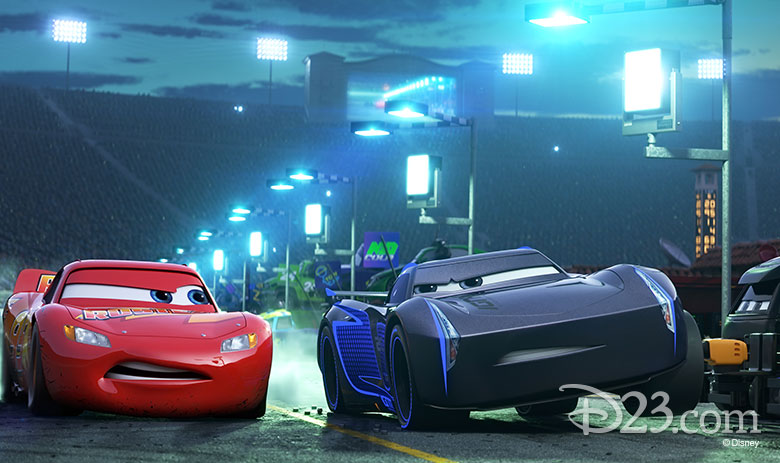
Getting input from automotive experts
To create the best car designs possible, the Pixar team sought advice from top experts. First, they brought in J Mays, the former head of design at Ford Motor Company and a personal friend of John Lasseter, to help workshop designs. “It solidified, but more importantly, endorsed the direction that we were moving in at the,” says Shuster.
They then traveled to the Daytona 500 and presented these designs to famed crew chief Ray Evernham (triple Winston Cup winner with driver Jeff Gordon, who voices a character in the film), who helped them push the design even further. Then on to the Petersen Auto Museum. The Sonoma Raceway. The San Francisco Auto Show. And their own parking lot. Animators wanted these characters to be as believable and real as possible.
“It was a real challenge on Cars 3 to make sure that these characters were flexible, but also still paying homage to the fact that they are metal,” says Comet. “We wanted to stay true to the fact that these are real cars.”
The Pixar mechanics show off their newest models when Cars 3 opens in theaters June 16.



